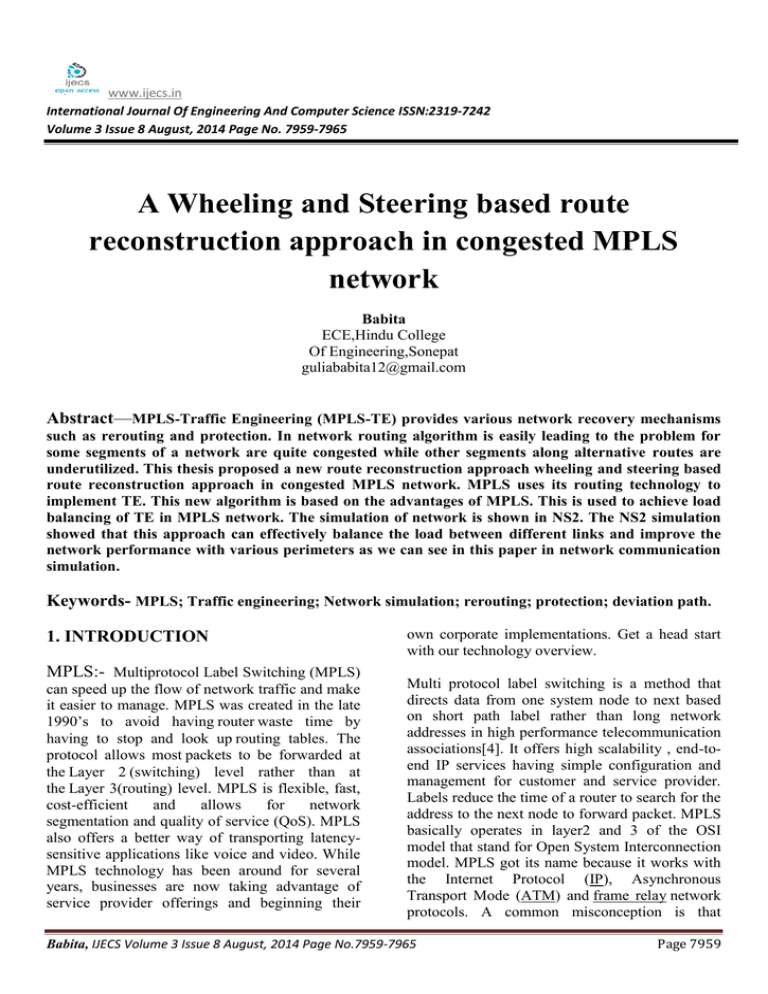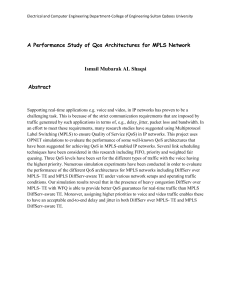Document 13994977
advertisement

www.ijecs.in International Journal Of Engineering And Computer Science ISSN:2319-7242 Volume 3 Issue 8 August, 2014 Page No. 7959-7965 A Wheeling and Steering based route reconstruction approach in congested MPLS network Babita ECE,Hindu College Of Engineering,Sonepat guliababita12@gmail.com Abstract—MPLS-Traffic Engineering (MPLS-TE) provides various network recovery mechanisms such as rerouting and protection. In network routing algorithm is easily leading to the problem for some segments of a network are quite congested while other segments along alternative routes are underutilized. This thesis proposed a new route reconstruction approach wheeling and steering based route reconstruction approach in congested MPLS network. MPLS uses its routing technology to implement TE. This new algorithm is based on the advantages of MPLS. This is used to achieve load balancing of TE in MPLS network. The simulation of network is shown in NS2. The NS2 simulation showed that this approach can effectively balance the load between different links and improve the network performance with various perimeters as we can see in this paper in network communication simulation. Keywords- MPLS; Traffic engineering; Network simulation; rerouting; protection; deviation path. 1. INTRODUCTION MPLS:- Multiprotocol Label Switching (MPLS) can speed up the flow of network traffic and make it easier to manage. MPLS was created in the late 1990’s to avoid having router waste time by having to stop and look up routing tables. The protocol allows most packets to be forwarded at the Layer 2 (switching) level rather than at the Layer 3(routing) level. MPLS is flexible, fast, cost-efficient and allows for network segmentation and quality of service (QoS). MPLS also offers a better way of transporting latencysensitive applications like voice and video. While MPLS technology has been around for several years, businesses are now taking advantage of service provider offerings and beginning their own corporate implementations. Get a head start with our technology overview. Multi protocol label switching is a method that directs data from one system node to next based on short path label rather than long network addresses in high performance telecommunication associations[4]. It offers high scalability , end-toend IP services having simple configuration and management for customer and service provider. Labels reduce the time of a router to search for the address to the next node to forward packet. MPLS basically operates in layer2 and 3 of the OSI model that stand for Open System Interconnection model. MPLS got its name because it works with the Internet Protocol (IP), Asynchronous Transport Mode (ATM) and frame relay network protocols. A common misconception is that Babita, IJECS Volume 3 Issue 8 August, 2014 Page No.7959-7965 Page 7959 MPLS is only used on private networks, but the protocol is used for all service provider networks - including Internet backbones [5]. MPLS supports a range of access technologies including ATM, Frame relay, PPP(point to point protocol), Packet over SONET, LAN technologies like that example such as Ethernet, Token ring and DSL that stand for digital subscriber line[3]. 2. Working methodology of MPLS forward IP packets across the network. The first (ingress) router inserts a label (or a stack of them) in front of the IP header and forwards the packet. All the subsequent routing switches ignore the IP headers and perform packet forwarding based on the labels in front of them. Finally, the egress router removes the label and forwards the original IP packet toward its final destination. The ability of MPLS to allocate a label is most considerable in business IP services. Set of labels is used to differentiate between routing information and application type. The label is compared with the pre computed switching table to apply the accurate IP Services to packet [3]. QOS manage when and how data is dropped when obstruction occurs trough network administrators [7]. 3. MPLS routing MPLS networks establish Label-Switched Paths (LSPs) for data crossing the network. An LSP is defined by a sequence of labels assigned to nodes on the packet path from source to destination. LSPs direct packets in one of two ways: hop-byhop routing or explicit routing. Figure 1. a simple MPLS network works. MPLS works by prefixing with an MPLS header having one or more label known label stack. With the contribution of MPLS-capable router or switches in central gateway protocols such as Open Shortest Path First (OSPF) or intermediate system to intermediate system (IS-IS), the network automatically builds routing tables. Label Distribution Protocol (LDP) uses this table to establish label values between neighboring devices. The entry and exit part of MPLS network is known as Label Edge Router (LERs). Trough LERs a packet enters label Switching Router (LSR) for processing to determine the service it requires like QOS and bandwidth management [6]. Each packet gets labeled at the edge of the service provider's network and that label determines which pre-determined path the packet will follow. The paths, which are called labelswitched paths (LSPs), allow service providers to decide ahead of time what will be the best way for certain types of traffic to flow within a private or public network. MPLS uses a variety of protocols to establish Label Switched Paths (LSPs) and 3.1 Hop-by-hop routing: In hop-by-hop routing, each MPLS router independently selects the next hop for a given Forwarding Equivalency Class (FEC). A FEC describes a group of packets of the same type; all packets assigned to a FEC receive the same routing treatment. FECs can be based on an IP address route or the service requirements for a packet, such as low latency. Figure 2. MPLS header format on an MPLS packet. In the case of hop-by-hop routing, MPLS uses the network topology information distributed by traditional Interior Gateway Protocols (IGPs) routing protocols such as OSPF or IS-IS. This process is similar to traditional routing in IP networks, and the LSPs follow the routes the IGPs dictate. Babita, IJECS Volume 3 Issue 8 August, 2014 Page No.7959-7965 Page 7960 3.2 Explicit routing: In explicit routing, the entire list of nodes traversed by the LSP is specified in advance. The path specified could be optimal or not, but is based on the overall view of the network topology and, potentially, on additional constraints. This is called Constraint-Based Routing. Along the path, resources may be reserved to ensure QoS. This permits traffic engineering to be deployed in the network to optimize use of bandwidth. 4. MPLS Traffic Engineering Traffic Engineering refers to the process of controlling traffic across a network with the purpose of balancing load on various links, router and switches, to make use of available bandwidth easy and increase the cost efficiency. A LSP is established for transporting traffic which different for standard destination based routing path [14]. Links and node failure leads to changes in routes which ultimately results in packet losses and delays in packet delivery. Thus node and link failures cause decreased QoS. MPLS provides guarantees for fast restoration in case of link and node failure [8]. Guaranteed performance for transporting real time traffic can be achieved using MPLS Traffic Engineering (MPLS-TE) capabilities [9]. MPLS-TE can utilized Fast Reroute (FRR) to mitigate packet loss associated with link and node failure[10]. Internet Engineering Task Force(IETF) has published various MPLS recovery mechanisms such as protection and rerouting[11]. MPLS protection schemes can be classified as either path-based backup or one-to-one backup schemes[10]. Using one-to-one backup scheme multiple recovery paths are pre-established, protecting each link and node. Further the upstream node at point of failure takes a rerouting destination as compared to ingress router in case of path based schemes. Thus, the one-to-one backup scheme has a faster response as compare to path-based schemes[1].Path-based schemes supports splitting of traffic over multiple pre-computed recovery paths performing load balancing. Path-based protection schemes using load balancing[12] would create problem of packet reordering and double bandwidth reservation results in poor utilization of bandwidth. Network congestion typically manifests under two scenarios: (1)When network resources are insufficient or inadequate to accommodate offered load. (2) when traffic streams are inefficiently mapped onto available resources; causing subsets of network resources to become over-utilized while others remain under-utilized[13]. Traditional routing algorithms Traditional IP routing algorithms like OSPF and ISIS compute the shortest path to destination and sent traffic through the same path. These algorithms having two problems The shortest paths from different sources cross over at some links, causing congestion on those links. The traffic from source to destination exceed the capacity of shortest path due to this longer path is under-utilized. Traffic Engineering is the process of controlling how traffic close through once network so as to optimize resource utilizing and network performance [14]. Minimizing congestion is main objective of traffic and resource oriented performance. 5. A Wheeling and Stearing based route reconstruction approach in congested MPLS network When the server backup is required to take or some bulk information is transferred, this kind of networks are every effective. This network is a wired communication network that provides the network stability and high speed communication over the network. But if some congestion or some attack occur in such networks, it can result heavy communication loss during the transmission. Because of this there is the requirement of effective route generation over the network so that the reliable packet delivery will be performed. MPLS network provides the dedicated communication between the linked communication network. This network type is effective to provide the effective routing in communication network. The presented work is focused on same network type. In this work, a Babita, IJECS Volume 3 Issue 8 August, 2014 Page No.7959-7965 Page 7961 contention window specification as well as back and forward node analysis approach is defined to identify the effective communication route. In this work, a multipath route identification scheme is defined by intelligent nodes. The loss rate analysis is performed as the major decision criteria to generate the effective route over the network. The work is about to reduce the communication loss and improve the network throughput. In this work, each node is defined as intelligent node that can take the decision regarding the route identification as well as to set the size of contention window. The route distribution along with contention window analysis is defined to perform the route reconfiguration and route reconstruction. The work is able to reduce the packet loss and improve communication throughput. The flow of presented work Define a dedicated MPLS network with N nodes Define the Source and Destination Node to perform the communication Perform the Back and forward node analysis to set the contention window size Identify the requirement of route diversion if some communication loss occur over the network The presented work is divided in two main stages. In first stage, the communication analysis is performed over the network nodes in terms of loss rate and delay analysis. If the loss rate is greater than expected threshold value, the node is identify as the critical node and some decision is taken to control the communication. In this work, the communication is controlled by setting up the size of contention window as well as by performing the route re construction. In this work, each node is identified as the intelligent node that monitor the back and forward node to perform reliable communication. 6. Research Design: The high speed MPLS network is presented in this work to reduce the congestion over the network and to improve the network throughput. The work is defined on wired communication between the intelligent server nodes where each node is able to take the decision regarding routing. Each intelligent node will monitor the forward and backward node respective to load and the loss rate. Based on these parameters, the decision will be taken to set a node as effective communication node. The node will work as the router as well as will observe the communication so that the decision regarding the contention window size is also taken effectively. The presented work is about to identify the network loss because of some attack or the congestion. Once the loss is identified, the route will be diverted to some other node or direction so that the effective communication will be performed. The work is about to perform the route reconstruction so that the communication loss over the network will be reduced. Simulation of Network Design Scenario Generate the Multipath route if some losses occurs over the node Perform communication analysis under different parameters Parameters Values Number of Nodes 23 Type of Network MPLS Simulation Time 10 Sec Packet Size 512 Delay 0.01 Babita, IJECS Volume 3 Issue 8 August, 2014 Page No.7959-7965 Page 7962 The following figure 4.1 is showing the design of connected MPLS network with communication link specification. The network is defined with specification of source and destination node. As MPLS is high speed communication network, here heavy data is transmitted to generate the congestion over the network. and reduce the leakage of the data with respect of time. Figure 4. Put nodes on communication (Existing approach) Figure 3. Network Design The communication is being performed in existing communication network , here heavy data loss is showing over the network because of congestion. The congestion is here occur over a centralized node. Because there is lots of data to transmit over the network .In this network if load is more then loss is more. As shown in this figure there is lots of leakage of data in this network at the source node. As the data load increases in network loss will also increase. The communication is being performed in proposed MPLS communication network and the data is communicated without having the heavy data loss. As the losses occur, the path diversion is performed to reduce the communication loss. As we can see our proposed network is having lesser loss for more data/packets of transmission. In the proposed work the communication is smoothly occur. So, by seeing both figures of network communication in existing work and proposed work the communication is more smooth and with lesser loss in the proposed work. As the time increases the communication is also going smooth in the network. After all, based on the analysis and evolution above we can tell that wheeling and stearing approach of route reconstruction can significantly increases bandwidth utilization ration Figure 5. Put nodes on communication (Proposed approach) Figure 6. Leakage in network after some time (Existing approach) Babita, IJECS Volume 3 Issue 8 August, 2014 Page No.7959-7965 Page 7963 Approach for MPLS-based Recovery,” IEEE ,2013. [2] Fnglin Li, jianxun Chen, “MPLS Traffic Engineering Load Balance Algorithm using Deviation Path,” IEEE/ICC, pp. 601-604,2012. Figure 7. Leakage in network after some time(proposed approach) [3] Jitendra Joshi,Sonali Gupta, Priti Gupta, Nisha Singh, Manjari Kumari, “Multi Protocol Label Switching with Quality of Service in High Speed Computer Network,” in IJESI/ISSN ;vol. 2, pp. 83-87 March 2013. [4] E. Roshan, et al., “Multi Protocol Label Switching Architecture”, IETF Internet Draft, work in progress, MPLS WG, February 1999. [5] B. Davie,et al., “MPLS using ATM VC Switching” , IETF Internet Draft, work in progress, MPLS WG, November 1998. [6] ‘IP Quality of Service: the complete resource for understanding and deploying IP quality of service for Cisco networks”, S.Vegesna, Cisco Press, 2001. Figure 8. Smooth communication in network as time increases (Proposed approach) 7. Conclusion The presented research work is about to identify an effective communication scheme in dedicated MPLS network. The presented work is about to perform the route identification and generation scheme in MPLS network. The work is about to reduce the communication loss in high speed congested network. Each node is defined as the intelligent node to take the decision about the route identification and contention window size specification. The work is divided in two main phases. In earlier phase, the network is monitored regarding the communication loss analysis. Once the loss is identified, the next work is to generate the effective route to perform the reliable communication over the network. References [1] Seema Anand Ladhe, Vijay T. Raisinghani, “A Resource Efficient Common Protection Path [7] V.Fineberg, C. Chen , and X. Xiao, “An endto-end QoS architecture with the MPLS-based core,” in IEEE Workshop on IP Operation and Management, 2002, pp. 26-30. [8] Randeep S. Bhatia, Murali Kodialam, T. V. Laksman, and Sudipta Sengupta, “Bandwidth Guaranteed Routine with Fast Restoration Against Link and Node Failures,” in IEEE/ACM Transactions on Networking, vol. 16, pp. 13211330, 2008. [9] Jasmina Barakovic, Himzo Bajric and Amir Husic, “Multimedia Traffic Analysis of MPLS and non-MPLS Network,” in Multimedia Signal Processing and Communications, 48th International Symposisum ELMAR, focused on, Zadar, pp. 285-288, 2006. [10] P.Pan, G. Swallow and A. Atlas., “Fast Reroute Extensions to RSVP-TE for LSP Tunnels,” in IETF RFC 4090 , 2005. [11] V. Sharma, Ed. Metanoia, Inc., F. Hellstrand Ed., “Framework for MPLS-based Recovery,” in IETF RFC 3469, 2003. Babita, IJECS Volume 3 Issue 8 August, 2014 Page No.7959-7965 Page 7964 [12] Martin Suchara, Dahai Xu, Robert Doverspike, David Johnson, Jennifer Rexford., “Network Architecture for Joint Failure Recovery and Traffic Engineering ,” in ACM SIGMETRICS, vol. 39 , Issue 1, pp. 97-108, 2011. [13] D.Awduche, J.Malcolm, J.Agogbua, M.O’Dell and J.McManus, “Requirements for Traffic Engineering Over MPLS,” RFC2702 IETF, September 1999. [14] Xipeng Xiao, Alan Hannan, Brook Bailey and Lionel Ni, “Traffic Engineering with MPLS in the Internet,” IEEE Network, pp. 28-33, MarchApril 2000. Babita, IJECS Volume 3 Issue 8 August, 2014 Page No.7959-7965 Page 7965






